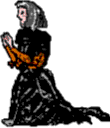A growing movement
At Elizabeth's accession the Puritans were a small political pressure group led by the Marian exiles, most of whom had returned from Geneva and Munich full of Calvinistic ambition*. Eventually they became a powerful and radical* political movement.
Most Protestants looked to the exiles for leadership during the anti-Catholic euphoria that followed the era of "Bloody" Mary*; but Elizabeth shrewdly appointed many of the exiles to offices in the Church, bringing their interests in line with her own conservative policies.
At first the Queen's compromise was generally accepted as a temporary expedient to avoid civil strife; but over the course of the 1560s Protestants realized that Elizabeth's intention was to maintain the status quo, enforcing conformity on both Catholics and Puritans alike*.
Footnotes
-
Theological ambitions
Characteristic of Puritan thinking was an emphasis upon strict adherence to the Bible and the rejection of any church practices without Scriptural origins.
-
Radicalism
One of their radical beliefs was that women should be educated in religious subjects, and that they were in some respects to be treated as equal partners in marriage--though this belief fell well short of what we would consider equality today.
-
Puritan martyrs
John Foxe's Book of Martyrs became highly popular and influential, commemorating those Godly Protestants who had died for their faith under Mary's tyranny. Click for more on Queen Mary.
-
Elizabeth and religious conformity
Elizabeth at first kept her orders to suppress nonconformity unofficial; at her request, Archbishop Parker began a campaign in 1564 to enforce the wearing of ritual vestments, suppress prophesyings, and expel disobedient clergy from their posts. As they were vestiges of Catholicism, vestments were referred to colourfully by Puritans as "rags of Antichrist."
Popular prophesying
Prophesyings were meetings of local clergy to discuss sermons, scripture, and clerical discipline. Most bishops supported their use as a means to correct abuses and improve the abilities of the preaching ministry. But Elizabeth knew that these meetings were also used to spread Puritanism. Their popularity led them to be continued under the guise of communal fasts after they were banned.
